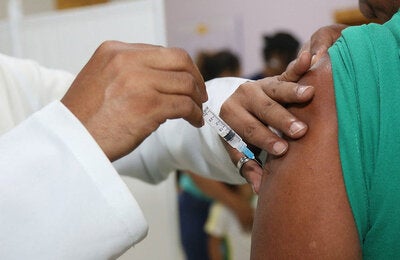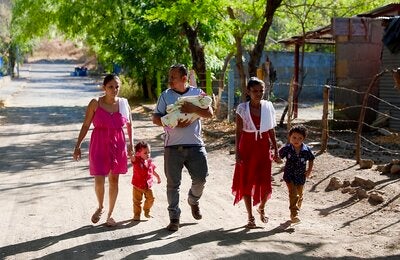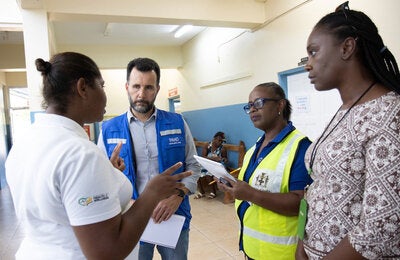
- First ever estimates of the global burden of foodborne diseases show almost 1 in 10 people fall ill every year from eating contaminated food and 420 000 die as a result
- Children under 5 years of age are at particularly high risk, with 125 000 children dying from foodborne diseases every year
- WHO African and South-East Asia Regions have the highest burden of foodborne diseases
3 DECEMBER 2015 | GENEVA - Almost one third (30%) of all deaths from foodborne diseases are in children under the age of 5 years, despite the fact that they make up only 9% of the global population. This is among the findings of WHO's "Estimates of the global burden of foodborne diseases" — the most comprehensive report to date on the impact of contaminated food on health and well-being.
The report, which estimates the burden of foodborne diseases caused by 31 agents — bacteria, viruses, parasites, toxins and chemicals — states that each year as many as 600 million, or almost 1 in 10 people in the world, fall ill after consuming contaminated food. Of these, 420 000 people die, including 125 000 children under the age of 5 years.
"Until now, estimates of foodborne diseases were vague and imprecise. This concealed the true human costs of contaminated food. This report sets the record straight," says Dr Margaret Chan, Director-General of WHO. "Knowing which foodborne pathogens are causing the biggest problems in which parts of the world can generate targeted action by the public, governments, and the food industry."
While the burden of foodborne diseases is a public health concern globally, the WHO African and South-East Asia Regions have the highest incidence and highest death rates, including among children under the age of 5 years.
"These estimates are the result of a decade of work, including input from more than 100 experts from around the world. They are conservative, and more needs to be done to improve the availability of data on the burden of foodborne diseases. But based on what we know now, it is apparent that the global burden of foodborne diseases is considerable, affecting people all over the world — particularly children under 5 years of age and people in low-income areas," says Dr Kazuaki Miyagishima, Director of WHO's Department of Food Safety and Zoonoses.
Diarrhoeal diseases are responsible for more than half of the global burden of foodborne diseases, causing 550 million people to fall ill and 230 000 deaths every year. Children are at particular risk of foodborne diarrhoeal diseases, with 220 million falling ill and 96 000 dying every year. Diarrhoea is often caused by eating raw or undercooked meat, eggs, fresh produce and dairy products contaminated by norovirus, Campylobacter, non-typhoidal Salmonella and pathogenic E. coli.
Other major contributors to the global burden of foodborne diseases are typhoid fever, hepatitis A, Taenia solium (a tapeworm), and aflatoxin (produced by mould on grain that is stored inappropriately).
Certain diseases, such as those caused by non-typhoidal Salmonella, are a public health concern across all regions of the world, in high- and low-income countries alike. Other diseases, such as typhoid fever, foodborne cholera, and those caused by pathogenic E. coli, are much more common to low-income countries, while Campylobacter is an important pathogen in high-income countries.
The risk of foodborne diseases is most severe in low- and middle-income countries, linked to preparing food with unsafe water; poor hygiene and inadequate conditions in food production and storage; lower levels of literacy and education; and insufficient food safety legislation or implementation of such legislation.
Foodborne diseases can cause short-term symptoms, such as nausea, vomiting and diarrhoea (commonly referred to as food poisoning), but can also cause longer-term illnesses, such as cancer, kidney or liver failure, brain and neural disorders. These diseases may be more serious in children, pregnant women, and those who are older or have a weakened immune system. Children who survive some of the more serious foodborne diseases may suffer from delayed physical and mental development, impacting their quality of life permanently.
Food safety is a shared responsibility, says WHO. The report's findings underscore the global threat posed by foodborne diseases and reinforce the need for governments, the food industry and individuals to do more to make food safe and prevent foodborne diseases. There remains a significant need for education and training on the prevention of foodborne diseases among food producers, suppliers, handlers and the general public. WHO is working closely with national governments to help set and implement food safety strategies and policies that will in turn have a positive impact on the safety of food in the global marketplace.
Note to the editor:
In addition to disease incidence and deaths, the WHO report and PLOS papers also quantify the disease burden in terms of Disability-Adjusted Life Years (DALYs)—the number of healthy years of life lost due to illness and death—to facilitate ranking between causes of disease and across regions. The global burden of foodborne diseases caused by the 31 hazards in 2010 was 33 million DALYs; children under 5 years old bore 40% of this burden.
The policy and social impact of this report will be discussed in detail at a symposium organised by WHO and the Dutch National Institute for Public Health and the Environment (RIVM), 15-16 December in Amsterdam.
FERG symposium
For more information, contact:
Fadéla Chaib, WHO | Telephone: +41 22 791 32 28 | Mobile: +41 79 475 55 56 | E-mail: chaibf@who.int
Olivia Lawe-Davies, WHO | Telephone: +41-22-7911209 | Mobile: +41-794755545 | Email: lawedavieso@who.int
Highlights of the Report by WHO Region
WHO African Region
The WHO African Region was estimated to have the highest burden of foodborne diseases per population. More than 91 million people are estimated to fall ill and 137 000 die each year.
Diarrhoeal diseases are responsible for 70% of foodborne diseases in the African Region. Non-typhoidal Salmonella, which can be caused by contaminated eggs and poultry, causes the most deaths, killing 32 000 a year in the Region—more than half of the global deaths from the disease. 10% of the overall foodborne disease burden in this Region is caused by Taenia solium (the pork tapeworm).
Chemical hazards, specifically cyanide and aflatoxin, cause one quarter of deaths from foodborne diseases in the Region. Konzo, a particular form of paralysis caused by cyanide in cassava, is unique to the African Region, resulting in death in 1 in 5 people affected.
WHO Region of the Americas
The WHO Region of the Americas is estimated to have the second lowest burden of foodborne diseases globally. Nevertheless 77 million people still fall ill every year from contaminated food, with an estimated 9000 deaths annually in the Region. Of those who fall ill, 31 million are under the age of 5 years, resulting in more than 2000 of these children dying a year.
While the overall burden of diarrhoeal diseases is lower than in other Regions, it is still the most common foodborne disease in the Region of the Americas with Norovirus, Campylobacter, E. coli and non-typhoidal Salmonella causing 95% of cases.
Toxoplasmosis and the pork tapeworm (Taenia solium) are very important food safety concerns in the Central and South America. Toxoplasmosis is spread through undercooked or raw meat and fresh produce, and can result in impaired vision and neurological conditions.
WHO Eastern Mediterranean Region
The Eastern Mediterranean Region has the third highest estimated burden of foodborne diseases per population, after the African and South-East Asia Regions. More than 100 million people living in the Eastern Mediterranean Region are estimated to become ill with a foodborne disease every year and 32 million of those affected are children under 5 years.
Diarrhoeal diseases (caused by E. coli, Norovirus, Campylobacter and non-typhoidal Salmonella) account for 70% of the burden of foodborne disease.
An estimated 37 000 people in the Eastern Mediterranean Region die each year from unsafe food, caused primarily by diarrhoeal diseases, typohoid fever, hepatitis A, and brucellosis. Both typhoid fever and hepatitis A are contracted from food contaminated by the faeces of an infected person and brucellosis is commonly caused by unpasteurized milk or cheese of infected goats or sheep. Half of the global cases of brucellosis are in people living in this Region, with more than 195 000 people infected every year, causing fever, muscle pain or more severe arthritis, chronic fatigue, neurologic symptoms and depression.
WHO European Region
The report highlights that although the WHO European Region has the lowest estimated burden of foodborne diseases globally, more than 23 million people in the Region fall ill from unsafe food every year, resulting in 5000 deaths.
Diarrhoeal diseases account for the majority of foodborne illnesses in the WHO European Region with the most common being Norovirus infections, causing an estimated 15 million cases, followed by campylobacteriosis, causing close to 5 million cases. Non-typhoid salmonellosis causes the highest number of deaths—almost 2000 annually.
Foodborne toxoplasmosis, a severe parasitic disease spread through undercooked or raw meat and fresh produce, may cause up to 20% of the total foodborne disease burden and affects more than 1 million people in the Region each year. Listeria infection also has a severe impact on the health of people who contract it and causes an estimated 400 deaths in the European Region annually. Listeria can result in septicaemia and meningitis, and is usually spread by consuming contaminated raw vegetables, ready-to-eat meals, processed meats, smoked fish or soft cheeses.
WHO South-East Asia Region
The WHO South-East Asia Region has the second highest burden of foodborne diseases per population, after the African Region. However, in terms of absolute numbers, more people living in the WHO South-East Asia Region fall ill and die from foodborne diseases every year than in any other WHO Region, with more than 150 million cases and 175 000 deaths a year. Some 60 million children under the age of 5 fall ill and 50 000 die from foodborne diseases in the South-East Asia Region every year.
Diarrhoeal disease causing agents, Norovirus, non-typhoidal Salmonella and pathogenic E. coli cause the majority of foodborne disease deaths in the Region. Additionally, the pork tapeworm (Taenia solium) has a major impact on health. It can cause cysts to develop in the brain, which is the most frequent preventable cause of epilepsy worldwide.
Globally, half of the people who are infected and die from either Typhoid fever or hepatitis A reside in the South-East Asia Region.
WHO Western Pacific Region
Every year, 125 million people in the WHO Western Pacific Region become ill from contaminated food, causing more than 50 000 deaths. As in other Regions, the burden is highest in children under 5 years of age with 40 million falling ill and 7000 dying every year.
Unlike other Regions of the world, where diarrhoeal diseases cause the highest proportion of deaths, aflatoxin is estimated to be the leading cause of foodborne disease deaths in the Western Pacific Region. Aflatoxin is a toxin produced by mould that grows on grain that has been stored inappropriately, and can cause liver cancer, one of the most deadly forms of cancer. More than 10 000 people in the Western Pacific are estimated to develop liver cancer due to aflatoxin every year, with the disease proving fatal in 9 out of 10 people. An estimated 70% of people who become ill from aflatoxin worldwide live in the WHO Western Pacific Region.
The Western Pacific Region also has the highest death rate from foodborne parasites, particularly the Chinese liver fluke (Clonorchis sinensis), Echinococcus multilocularis and Taenia solium (the pork tapeworm). The Chinese liver fluke, which is commonly contracted through raw and incorrectly processed or cooked fish, infects more than 30 000 people in the Region a year, causing death in 1 in 5 cases. Almost all of those who are infected with Chinese liver fluke in the world live in the Western Pacific. The highest disease burden results from the disabling impact of Paragonimus spp. infections of the lungs and central nervous system.
Links
— Report: WHO Estimates of the Global Burden of FoodBorne Diseases



